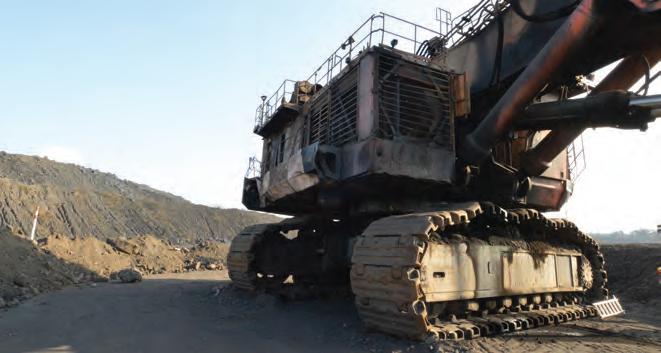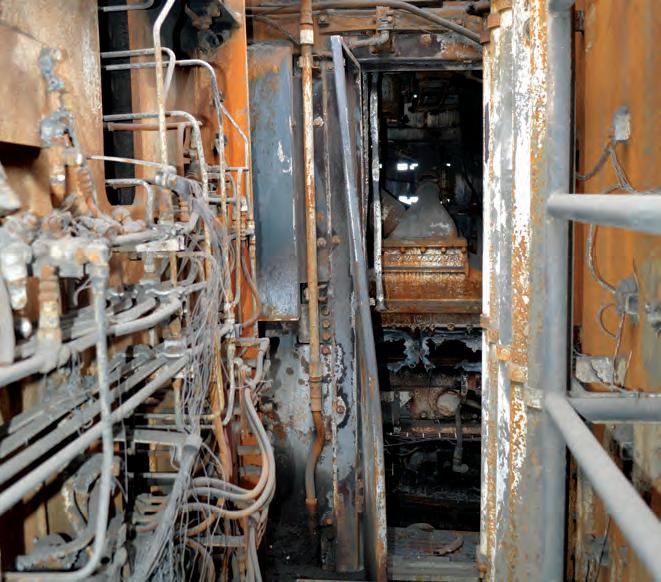
5 minute read
Mining’s criminal curveball
Risk Management Mining’s criminal curveball
WHILE THEY MAKE UP A SMALL PROPORTION OF MINE SITE INCIDENTS, DELIBERATELY LIT FIRES ARE JUST AS DEADLY AS ANY OTHER SAFETY INCURSION AND MUST BE MET WITH THE SAME URGENCY.
Mining fires predominantly occur haphazardly, with flammable liquids igniting with a fuel source to spark combustion.
Fires can be created from fixed and mobile plant malfunctions or maintenance tasks that involve hot work and hot metal or slag kindling with a source.
Conveyor belts can also cause fires, whereby excessive friction on pulleys and rollers can create an ignition. There’s also the potential for fires to be deliberately lit.
An arsonist caused the 2014 Hazelwood coal mine fire in Victoria. The fire commenced inside an open cut mine and burned for 45 days, clouding Morwell in smoke and forcing the town’s residents to evacuate.
Fire Forensics senior fire investigator Keith Murray says deliberately lit fires bear unique characteristics from accidental ignitions.
“There’s evidence and trails that you can recognise. The one I can think of, just a couple of months ago that I attended, was the fire destroyed an excavator,” Murray says.
“From the external scene examination, there was debris lying to the side. One part of the debris was the cab door. Analysing the door frame, there was a small dent in the metalwork to the top of the door.
“Placing the door back onto the excavator, you could see there was a gouge mark between the top of the door and the actual door frame. So, someone had tried to prise the door open. That was the first tell-tale sign or indicator for me of a deliberate act.”
Murray says the location of the remains can also indicate the sequence of events and paint a picture of how the fire developed.
“The second was the debris within the cab. If you break toughened glass, the glass will fragment into small pieces and fall onto the cab’s floor and outside the excavator. Once the fire is set, the fire destroys the cab’s contents and falls on top of the glass,” he says.
“The glass then actually protects the floor, creating protection marks on the floor, in addition, the glass is also clean on both sides with no smoke staining.
“You can observe this when you scrape the top debris away to reveal glass away. The cub floor underneath is clean, having been protected from the glass particles. So, if the fire started in the excavator, you would have a lot of smoke, a lot of soot, a lot of
Thievery can play a big part in deliberately lit mining fires.
Deliberately lit fires are just as deadly as any other mining safety incursion.

burning debris on the floor.
“However, the glass was there before the debris, which indicated to me that there was malicious intent.”
Other deliberate fire indicators can include the use of accelerant or ignitable liquids. This can be evidenced by laboratory analysis – from the samples taken from the scene of a fire – to confirm their presence.
Modern technology now offers mining companies a real-time understanding of how their machinery operates. The use of telematics provides accurate data to facilitate proactive measures such as operations of the machinery and preventative maintenance.
Telematics has also advanced the investigation of deliberately lit mining fires. The data capture enables fire investigators to understand the chronology and location of certain criminal behaviours.
“You can get the telematics from the manufacturer for that specific machinery on the permission of the owner to understand how it was operating at the time of the fire,” Murray says.
“The telematics records display a variety of information from; its location, how long it was used for, the time, when someone was sitting on the seat, if the ignition was on or off, the fuel used, the temperature etc.
“In this case, they couldn’t start the excavator, so the next thing is the battery terminal display on the telematics displays no battery which indicates to us that something has happened to the battery, i.e. this is when the fire attacked the battery, in this case.”
Murray says there are a few prevailing rationales behind deliberately lit fires, and thievery can play a big part in these incidents.
“There are probably two main motives for fires in machinery. Stealing parts off the machinery; I’ve also come across fires where the arsonist has been stealing diesel from the actual vehicles itself,” Murray says.
“They could also be trying to steal the excavator to take it away and sell it on. But again, you might be able to do that with an older system, but the newer systems that they’ve got in these excavators are probably nigh-onimpossible to get away with now unless you know what you’re doing.”
Hailing from Scotland, Murray has recently joined Fire Forensics as a senior fire investigator where he will be heading up the company’s new Western Australia office.
He brings more than 30 years in the Fire and Rescue Service and more than 15 years of experience in fire and explosions investigation. He has scrutinised fires in locations such as Texas, Mississippi, Poland, Scotland, England, Wales, France and Ireland.
“Fire Forensics is looking to expand its presence; with a strong foothold in the eastern states, the company has identified the mining-rich Western Australia as a particular priority,” he says.
“The company wanted to expand to Perth, so Jim Munday (Fire Forensics founder and senior fire investigator) moved to the Perth area, but he only wanted to do part-time,” Keith says.
“So, I’ve come in to support Jim and now we want to expand to Western Australia and the Northern Territory in the next year or two and build up the client base that Fire Forensics has already got in Victoria and New South Wales.
“We’re going to build a small team in Perth initially … and then see how we go and will hopefully increase our team to cover Western and the Northern Territory of Australia and potentially into Asia in the near future.”
Keith expects that a proportion of his time will be spent on Western Australia mine sites, familiarising himself with the industry and understanding the safety risks unique to the Pilbara, Mid-West, Goldfields and beyond.
Whether he’s faced with a deliberately lit fire or not, Keith has a vital role to play in consolidating the safety standards of one of the world’s most proliferate mining jurisdictions.

Telematics has advanced the investigation of deliberately lit mining fires.










